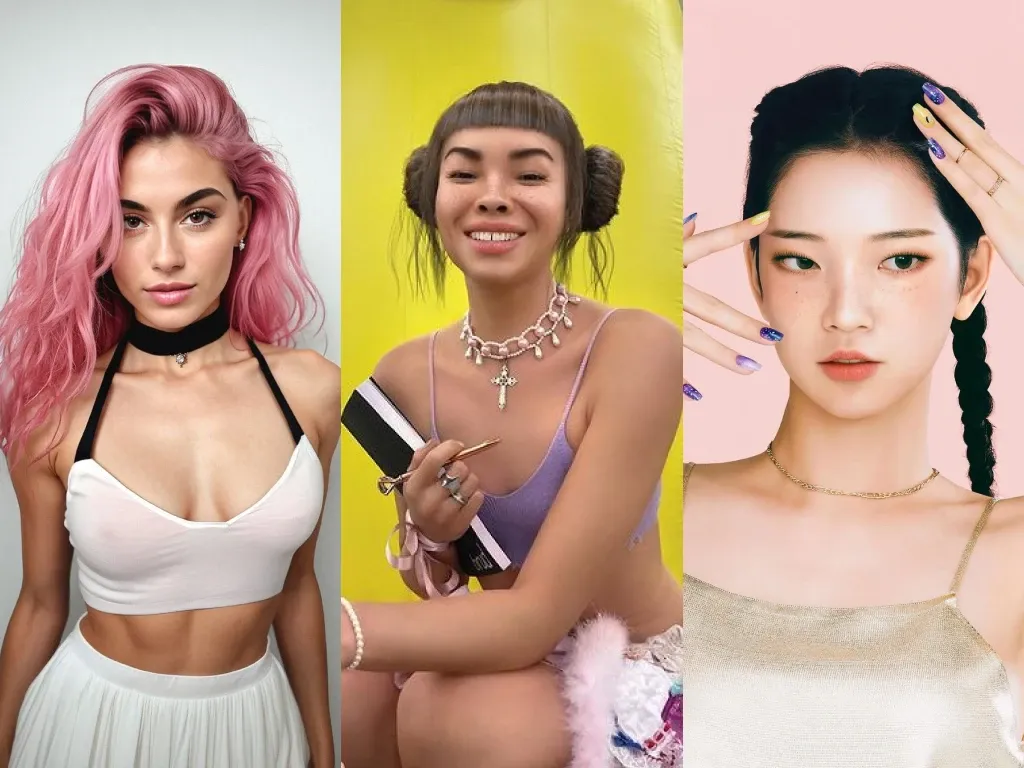These Influencers Aren't Flesh and Blood, Yet Millions Follow Them on Instagram - YEET

By YEET MAGAZINE | Updated 0200 GMT (1000 HKT) January 31, 2025
For some time now, social media—Instagram in particular—has witnessed the rise of strange, half-human, half-robot avatars: virtual influencers. This phenomenon is as fascinating as it is unsettling.
Take Lil Miquela, with her 3 million followers on Instagram, or FN Meka, who boasts 9.4 million followers and 118 million likes on TikTok. Then there's Nobody Sausage, with 7.2 million followers and 78.7 million likes, and Hatsune Miku, who has 2.4 million followers on Facebook. The numbers are staggering. While influencers with millions of followers are nothing new, these ones are different—they're not human. They’re fully digital creations, avatars that exist solely on social networks.
From singers and rappers to models and dancers, these virtual influencers are multifaceted and appeal to a wide audience. Don’t worry—they’re not here to take over the world. Their purpose is simple: to drive consumerism. These digital personas promote brands, products, and technologies through posts, photos, and videos. And unlike real influencers, they don’t demand creative freedom—they are entirely controlled by their creators.
From humanoid characters to animals and even a pink sausage that dances on TikTok, virtual influencers come in all shapes and forms.


The aim of Ayanda, who herself already has over 1.8 million followers on Instagram, is also to explore the possibilities of the virtual world . “I think it is important to look at the possibilities of artificial intelligence, what it has in store for the future and especially for my continent, Africa.
I am very happy to be the first African to create an avatar, which looks like an African like me, made by Africans and who will be able to tell African stories, ”adds the young woman. Through iYanda, she hopes to be able to inspire and offer new content.
A story of technology
But how are these digital influencers created? Behind all these designs, there are companies, companies and agencies that are eye-catching with their technology. Factory New with FN Meka, The Avatar Company with iYanda, Crypton Future Media with Hatsune Miku, Havah Studio with Yasmine Varma , all these companies have developed these avatars using different technologies. FN Meka, Lil Miquela or iYanda were entirely modeled by computer.
Felix Renout used a real mannequin and then modeled a face and harmonized it with the body using Reality Labs, an artificial intelligence software from Facebook. “ We were inspired by the research work of a cosmetic surgeon who established beauty codes. We imported our work into modeling software and from that base we developed a face, ”says Felix Renout. Taking just one of these photos takes her three-person team between five and six hours.
Advantage: having only the face to be made is a way to better control the light in the photo, but also to have a real piece of clothing from a partner brand directly worn by the model, instead of recreating it as a synthetic image.
These virtual influencers need to catch the eye with their semblance of reality and be virtual enough not to scare . We therefore notice the head of Yasmine Varma straight out of a video game mounted on a real human body. Because the goal of these avatars is not necessarily to appear real, but just to offer a limitless universe. This can sometimes be confusing. “I thought it was a normal girl who took a picture of herself and who, each time, inscribed on her real head, her face modeled in 3D. I thought it was just a real person who didn't want to show her face, ”says Chloë, 22, a styling student, referring to Lil Miquela.
There is something to get lost in when you see that the influencer sometimes poses with real people, or wears clothes that exist in reality.
A Story to Tell
“OMG TOO BEAUTIFUL I LOVE YOU TOO MUCH!” Comments like these flood Lil Miquela’s Instagram posts. With her bangs, twin buns, and freckled face, she looks like a typical 19-year-old—except she’s not real. And that’s exactly what draws her audience in.
Creators give virtual influencers detailed backstories to make them relatable. Felix Renout, creator of Yasmine Varma, the first French virtual influencer, explains, “We create a past for the avatar to develop its personality using psychology and plans for the future.”
Avatars like FN Meka and iYanda have hobbies and passions, from rapping and collecting luxury items to yoga and fashion shoots. Some even take strong stances on social issues: Lil Miquela supports Black Lives Matter, advocates for LGBTQ+ rights, and raises awareness about climate change.
However, there’s criticism too. In 2019, Brud Inc.—Lil Miquela’s creators—faced backlash for a vlog in which the avatar detailed a fictional sexual assault, raising questions about the exploitation of social issues for engagement.
Ultimately, creating rich, relatable personalities helps these avatars connect with audiences. Without compelling backstories, they’d struggle to stand out.
A Story of Money
Make no mistake—the influencer world, virtual or not, is all about profit. For instance, interviewing TikTok’s Nobody Sausage costs €200, proving how lucrative this industry is.
Virtual influencers collaborate with brands across industries—from food and fashion to tech and cars. Lil Miquela, for example, promoted the electric MINI, showcasing the commercial appeal of avatars. Felix Renout notes, “Virtual influencers give brands greater control. Unlike real influencers, avatars don’t risk scandals.”
Virtual influencers also cut costs for agencies, eliminating expenses like travel, hotels, and support teams. For creators like Lebo Kambule of The Avatar Company, avatars showcase a company’s design and innovation capabilities while staying ahead of social media trends.
Why Follow Virtual Influencers?
Why follow these “lab-made” personalities? Consider this: what’s the difference between real influencers like Nabilla and virtual ones like Lil Miquela? Both curate their lives for social media, but Lil Miquela’s slick, video-game-like appearance adds intrigue.
“These avatars are innovative,” says Renout. “Traditional influencers often repeat the same messages. We wanted to create something fresh and original to captivate users.”
Avatars can be whatever they need to be—stylish, funny, cool, or relatable. Lil Miquela made Time’s list of the Top 25 Most Influential People on the Internet in 2018. By 2019, her creators, Brud Inc., were valued at over $125 million.
Virtual influencers reflect a growing shift toward immersive, digital worlds. As designer Chloë notes, “We’re seeing tools that make these virtual spaces increasingly realistic, creating an alternate universe.”
But this innovation also stirs controversy. In 2018, Rihanna’s Fenty brand cast virtual model Shudu Gram, sparking debate about virtual avatars replacing real models. While some see avatars as the future, others worry about the impact on real-world opportunities.
Hiring now! Join the YEET Magazine Team – Remote Job Opportunities in Digital Media
Work anywhere, thrive everywhere—start your journey with YEET today!
Ready to take the next step in your career? Discover our open positions and exciting opportunities below:
Don't wait—explore these roles and start your career with YEET Magazine!
Ready to apply? Start here, browse YEET's CAREER PAGE
View more YEET Magazine Career Opportunities at YEET
Discover More on Innoverse by YEET
Stay ahead with the latest in technology, innovation, and groundbreaking insights from Innoverse by YEET Magazine. From AI breakthroughs to the newest gadgets, we've got the stories that matter.
21 Best Gadget Deals of 2025 Metaquest: Everyday Tech Redefined AI Predicts Future of Junk Food Impact Reality to Digital: Exploring Identity AI in 2025: What to Expect The Rise of Quantum Computing: What You Need to Know Next-Gen Smartphones 2025: Innovations to WatchExplore these stories and more on Innoverse by YEET Magazine. Your journey into the world of technology starts here!

